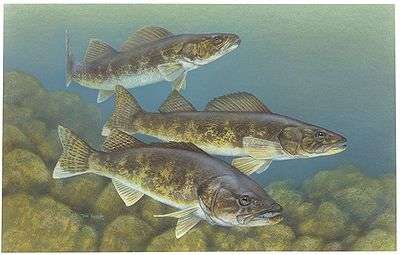Sander (fish)
Sander (formerly known as Stizostedion) is a genus of fish in the Percidae (perch) family. They are also known as "pike-perch" because of their resemblance to fish in the unrelated Esocidae (pike) family.
| Sander | |
|---|---|
 | |
| Walleye (Sander vitreus) | |
| Scientific classification | |
| Kingdom: | Animalia |
| Phylum: | Chordata |
| Class: | Actinopterygii |
| Order: | Perciformes |
| Family: | Percidae |
| Subfamily: | Luciopercinae |
| Genus: | Sander Oken, 1817 |
| Type species | |
| Perca lucioperca | |
| Species | |
|
| |
| Synonyms | |
| |
Local names for the fish have been the basis for many geographical names, like River Suda in Russia or Saunags village on the Baltic coast.
Species
The genus includes the following 5 species:
- Sander vitreus Mitchill, 1818 (Walleye)
- Sander lucioperca Linnaeus, 1758 (Zander)
- Sander canadensis Griffith & Smith, 1834 (Sauger)
- Sander marinus G. Cuvier, 1828 (Estuarine perch)
- Sander volgensis J. F. Gmelin, 1789 (Volga pikeperch)
Phylogeny
Phylogenetic relationships of the species of genus Sander based on the concatenated data set of six gene regions and a Bayesian analysis.[1] Romanichthys valsanicola is the nearest living relative of the genus Sander and is used as an outgroup to root the tree.
| |||||||||||||||||||||||||||||||
References
- A.E. Haponski and C.A. Stepien (2013). "Phylogenetic and biogeographical relationships of the Sander pikeperches (Percidae: Perciformes): patterns across North America and Eurasia". Biological Journal of the Linnean Society. 110: 156–179. doi:10.1111/bij.12114.
- "Sander". Integrated Taxonomic Information System. Retrieved 6 June 2006.